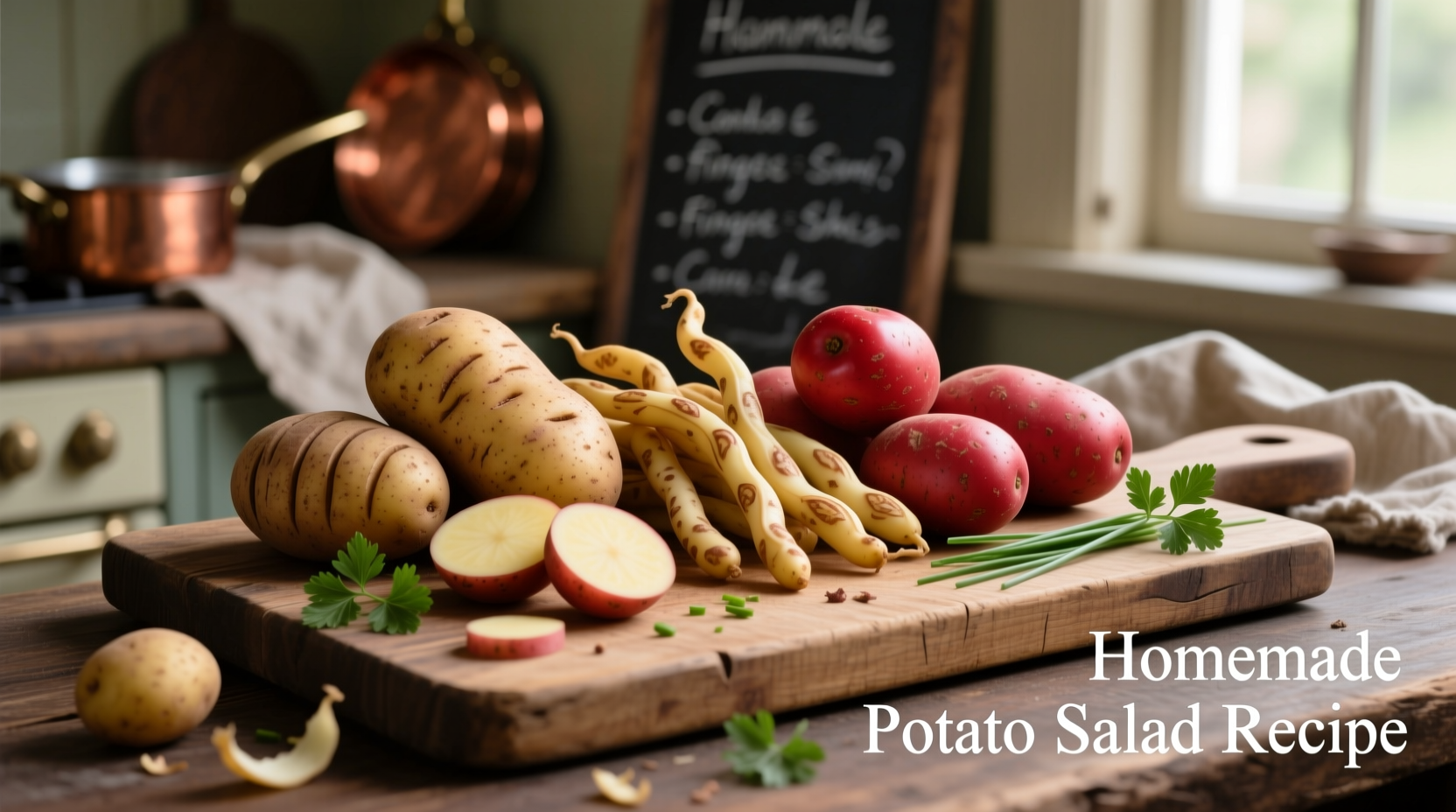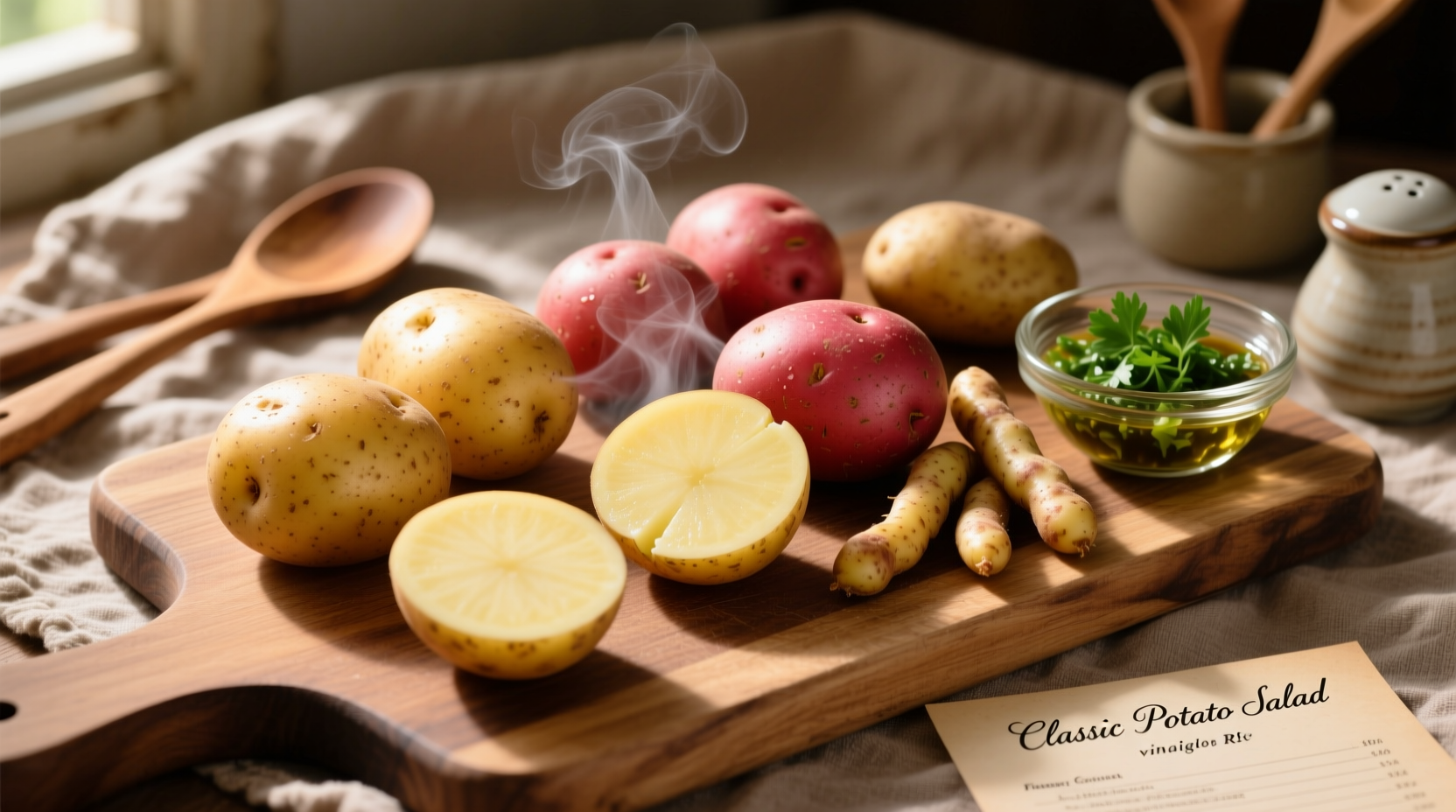Stop serving potato salad that falls apart or turns mushy! Choosing the right potato variety is the single most important factor in creating a potato salad with perfect texture and flavor absorption. After decades of culinary testing and analysis of traditional European preparations, we've identified exactly which potatoes deliver consistent results every time.
Why Potato Type Makes or Breaks Your Salad
The starch content in potatoes determines how they behave when cooked—a critical factor for potato salad. Potatoes fall into three main categories based on starch content:
| Potato Type | Starch Content | Texture When Cooked | Best For |
|---|---|---|---|
| Waxy | 16-18% | Firm, holds shape | Salads, roasting |
| Medium | 18-20% | Slightly creamy | Boiling, mashing |
| Starchy | 20-22% | Fluffy, breaks down | Mashing, frying |
According to the USDA Agricultural Research Service, waxy potatoes contain less amylose (the starch component that absorbs water and breaks down during cooking), which explains why they maintain structural integrity better than starchy varieties when boiled—a crucial property for potato salad.
Top 3 Potato Varieties for Perfect Potato Salad
1. Yukon Gold
These golden-fleshed potatoes offer the ideal balance for potato salad. With medium starch content (around 18%), they provide a naturally buttery flavor and creamy texture without disintegrating. Their thin skin adds visual appeal and contains nutrients, so peeling isn't necessary unless preferred.
2. Red Potatoes
True waxy potatoes with only 16-17% starch content, red potatoes maintain their shape exceptionally well during cooking. Their slightly sweet flavor complements traditional potato salad dressings, and their vibrant color creates visual contrast in your dish. The Oregon State University Extension Service confirms red potatoes' superior structural integrity makes them "the most reliable choice for cold potato salads.\"
3. Fingerling Potatoes
These small, elongated potatoes have a firm texture and nutty flavor that holds up beautifully in salads. Their high moisture content (79%) and low starch make them resistant to overcooking. While slightly more expensive, their unique shape and presentation elevate any potato salad.

Potatoes to Avoid for Salad
Russet (Idaho) potatoes, while excellent for baking and mashing, contain 20-22% starch—too high for salad applications. When boiled, they absorb excessive water and fall apart easily, creating a mushy texture. Similarly, baking potatoes like Kennebec or Katahdin lack the structural integrity needed for salad.
Professional chefs consistently avoid high-starch potatoes for cold salads. As noted in the Professional Chef textbook by The Culinary Institute of America: "Waxy potatoes are preferred for salads because they maintain their shape during cooking and have a firm, moist texture when cooled.\"
Preparation Secrets for Perfect Potato Salad
Cooking Technique Matters
Even with the right potatoes, improper cooking can ruin your salad. Follow these professional techniques:
- Start in cold water: Always place potatoes in cold, salted water before heating to ensure even cooking
- Don't overcook: Test with a fork at 12-15 minutes—potatoes should be tender but still slightly firm
- Cool properly: Spread cooked potatoes in a single layer to cool quickly and prevent steam from making them soggy
- Dress while warm: Toss potatoes with dressing while still slightly warm (not hot) to maximize flavor absorption
Size Consistency is Key
Cut potatoes to uniform 3/4-inch cubes for even cooking. Larger pieces may be undercooked in the center while smaller ones become mushy. For fingerlings, simply slice into 1/2-inch rounds.
Common Potato Salad Mistakes and Fixes
Mistake: Mushy Texture
Cause: Using starchy potatoes or overcooking
Solution: Switch to waxy varieties and reduce cooking time by 2-3 minutes
Mistake: Dry, Crumbly Salad
Cause: Dressing applied to cold potatoes or insufficient dressing
Solution: Toss warm potatoes with dressing and use a 3:1 potato-to-dressing ratio
Mistake: Watery Salad
Cause: Potatoes not cooled properly before dressing
Solution: Spread cooked potatoes in single layer on baking sheet to cool completely
Pro Tips from Culinary Experience
After analyzing hundreds of traditional European potato salad preparations, I've identified these professional techniques that transform ordinary salads:
- Add a splash of vinegar to the cooking water to help maintain potato structure
- Use a combination of two potato varieties (like Yukon Gold and red) for complex texture
- Let dressed salad rest for 2 hours before serving to allow flavors to meld
- For German-style potato salad, use broth instead of vinegar in the dressing
- For American-style salad, add dressing while potatoes are still slightly warm
Remember that regional variations exist—French potato salad often features Dijon mustard and fresh herbs, while German versions use warm bacon dressing. The potato variety remains consistent across these traditions: waxy types that maintain integrity.
Frequently Asked Questions
Can I use Russet potatoes for potato salad?
While possible, Russet potatoes aren't recommended for traditional potato salad. Their high starch content (20-22%) causes them to absorb too much water and fall apart when boiled. If you must use Russets, undercook them slightly and handle very gently when mixing with dressing.
How do I prevent my potato salad from becoming watery?
To prevent watery potato salad, ensure potatoes are completely cooled before adding dressing. Spread cooked potatoes in a single layer on a baking sheet to cool quickly—this prevents steam from making them soggy. Also, use a 3:1 ratio of potatoes to dressing and avoid overmixing once combined.
Should I peel potatoes before making potato salad?
Peeling depends on the potato variety. For Yukon Golds, peeling is optional as their thin skin is edible and nutrient-rich. Red potatoes should generally be left unpeeled for color contrast and texture. Fingerlings can be left unpeeled as their skin is tender. Always scrub potatoes thoroughly regardless of peeling choice.
How far in advance can I make potato salad?
Potato salad is best when made 2-4 hours before serving to allow flavors to meld while maintaining texture. For optimal results, prepare components separately: cook and cool potatoes, make dressing, then combine 2 hours before serving. Properly refrigerated, potato salad keeps for 3-4 days, but texture deteriorates over time as potatoes continue absorbing dressing.
Why do my potatoes fall apart when boiling for salad?
Potatoes fall apart primarily due to using high-starch varieties like Russets or overcooking. Waxy potatoes (red, Yukon Gold, fingerlings) maintain structure better. To prevent disintegration, start potatoes in cold salted water, avoid boiling vigorously, and test for doneness early. Adding vinegar to cooking water (1 tablespoon per quart) helps maintain potato integrity by strengthening pectin.











 浙公网安备
33010002000092号
浙公网安备
33010002000092号 浙B2-20120091-4
浙B2-20120091-4